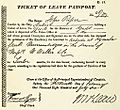Ticket of leave facts for kids
A ticket of leave was a special document given to convicts who were sent to Australia a long time ago. If a convict behaved well, they could get a ticket of leave. This meant they had more freedom and didn't have to stay in prison. With this ticket, they could look for work in a specific area. But they needed permission from a court to leave that area. Every time they changed jobs or moved to a new place, it was written on their ticket.
A New Start: The History of Tickets of Leave
Governor Philip Gidley King started the idea of tickets of leave in 1801. It was a clever way to encourage prisoners to behave better. It also helped provide workers for the new farms in Australia. The government saved money too, because they didn't have to feed and clothe as many prisoners.
People with a ticket of leave gained some important rights. They could marry or even bring their families from Britain to Australia. They could buy land, but they weren't allowed to carry guns or get on a ship. Often, they had to pay back the cost of their journey to Australia on the prison ship.
The ticket of leave had to be renewed every year. People with a ticket also had to attend muster (a check to make sure they were still in the area) and church services. Prisoners could lose their ticket and be sent back to prison if they were lazy. They could also lose it if they tried to get paid too much, or if they were rude to the police or soldiers. Sometimes, prisoners who helped the government, like by catching escaped convicts, might get a ticket of leave as a reward.
If a convict followed all the rules of their ticket of leave, they could get a conditional pardon. This happened after they had served half of their prison time. After that, they were no longer a convict. They could do almost anything, except leave the colony. If convicts did not follow the rules of their ticket, they could be arrested without warning. They might go to court without being able to argue their case. They could also lose everything they owned.
What Was on the Ticket?
The ticket itself was a very detailed document. It listed the convict's number and name. It also showed the ship they came on and the year they arrived in Australia. The captain's name, where they came from, and their job were also written down.
The ticket also included details about their wrongdoings. It listed the place and date of their trial, and how long their sentence was. Their birth date and what they looked like were also on the ticket. It showed the area where the prisoner was allowed to live. The court that gave out the ticket and the date it was given were also included. Any other rules or changes to where they lived were written on it too.
A lot of this information has been saved over time. This makes these tickets very important for people looking into their family history. They can learn a lot about their ancestors who came to Australia as convicts.
Images for kids



